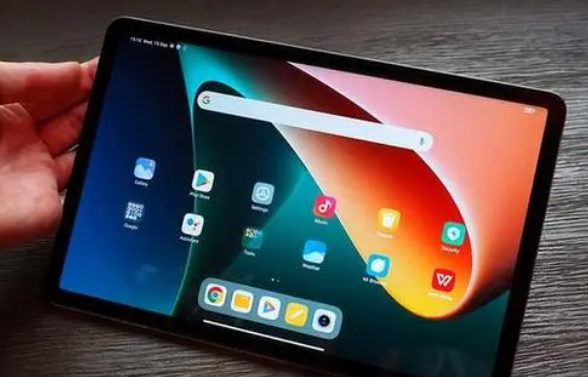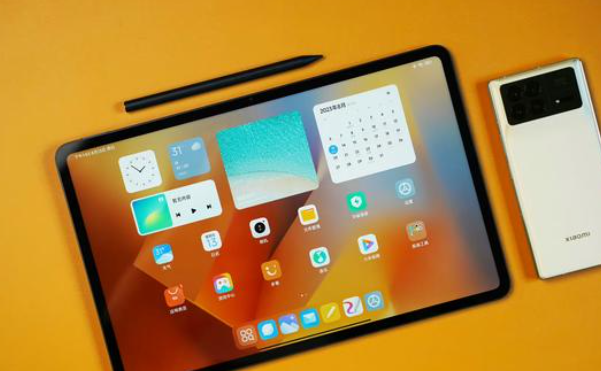Which one is better, Xiaomi Mi Pad 6 Tianma or Huaxing?
This time, Xiaomi Mi Pad 6 series products have different screen suppliers. Many users are not sure what the difference between the two suppliers is. In fact, from the actual situation, these two screens The suppliers are all similar.
Which one is better, Xiaomi Tablet 6 Pegasus or Huaxing?
Answer: TCL Huaxing’s is more eye-friendly and saves power.
Tianma’s screen will be more vivid, and the entertainment and gaming experience will be better.

TCL Huaxing Screen Introduction
1. LTPS Plus technology can support 30-144Hz adaptive refresh rate.
2. It can quickly adjust according to the screen content, save power and extend battery life.
3. LTPS Plus technology can also achieve hardware-level low blue light eye protection.
4. Overall, the entire screen will achieve many advantages such as high resolution, high refresh rate, low power consumption, and low flicker.
Tianma screen introduction
1. The parameters of Tianma screen are the same as those of Huaxing, and Tianma is also one of the largest LCD panel manufacturers in China, and is also a supplier of brands such as Apple and Samsung. .
2. Tianma also has independently developed flexible OLED technology and mass production capabilities
3. In terms of display effect, it will be more vivid and brighter, and the visual effect will be better. You can experience it while having fun.

The above is the detailed content of Which one is better, Xiaomi Mi Pad 6 Tianma or Huaxing?. For more information, please follow other related articles on the PHP Chinese website!

Hot AI Tools

Undresser.AI Undress
AI-powered app for creating realistic nude photos

AI Clothes Remover
Online AI tool for removing clothes from photos.

Undress AI Tool
Undress images for free

Clothoff.io
AI clothes remover

AI Hentai Generator
Generate AI Hentai for free.

Hot Article

Hot Tools

Notepad++7.3.1
Easy-to-use and free code editor

SublimeText3 Chinese version
Chinese version, very easy to use

Zend Studio 13.0.1
Powerful PHP integrated development environment

Dreamweaver CS6
Visual web development tools

SublimeText3 Mac version
God-level code editing software (SublimeText3)

Hot Topics
 How to set icon size for Xiaomi Mi Pad 6
Feb 07, 2024 pm 07:18 PM
How to set icon size for Xiaomi Mi Pad 6
Feb 07, 2024 pm 07:18 PM
Many users will encounter some icon adaptation problems when using them on tablets. At this time, we can set the icon to be larger or smaller, adjust it to the size you want, and then optimize the operation. How to set the icon size of Xiaomi Mi Pad 6: 1. Go to settings and find "Wallpaper and Personalization" 2. Then click "Icon" here 3. Then you can slide the pull bar to adjust the icon size.
 Xiaomi Mi Pad 6 series launches PC-level WPS in full volume! Same layout and operation as computer
Apr 25, 2024 pm 06:40 PM
Xiaomi Mi Pad 6 series launches PC-level WPS in full volume! Same layout and operation as computer
Apr 25, 2024 pm 06:40 PM
According to news on April 25, today, Xiaomi Tablet officially announced that Xiaomi Tablet 6, Xiaomi Tablet 6 Pro, Xiaomi Tablet 6 Max 14, and Xiaomi Tablet 6 S Pro now fully support PC-level WPSOffice. It is understood that Xiaomi Mi Pad 6 and Mi Pad 6 Pro need to upgrade the system version to V816.0.4.0 and above before they can download WPSOffice from the Xiaomi App Store. WPSOfficePCforPad has the same operation and page layout as the computer version, and is officially said to "achieve high efficiency on the tablet that is comparable to the computer version of WPS." In addition, in Xiaomi ThePaper OS, Xiaomi has also brought a new multi-tasking system to the Xiaomi tablet. , the interaction is similar to PC window mode, officially called self-
 Which one is worth buying, Xiaomi Mi Pad 6 or Pro?
Feb 07, 2024 pm 08:36 PM
Which one is worth buying, Xiaomi Mi Pad 6 or Pro?
Feb 07, 2024 pm 08:36 PM
Many users are not sure which one is worth buying, Xiaomi Mi Pad 6 or Mi Pad 6. From the configuration point of view, the higher configuration of Pro is definitely recommended, but it also depends on the price and their own budget, and the different product positioning groups are also different. Which one is worth buying, Xiaomi Mi Pad 6 or Pro? Answer: Xiaomi Mi Pad 6 Pro will be better, both in terms of performance and camera battery life. 1. Processor Xiaomi Pad 6: Snapdragon 870 Xiaomi Mi Pad 6 Pro: more powerful first-generation Snapdragon 8+ processor 2. Battery size Xiaomi Mi Pad 6: 8840mAh, 67W second charge Xiaomi Mi Pad 6 Pro: 8600mAh, 33W The fast-charging Xiaomi Mi Pad 6 will have better battery life, but charging will be slower. 3. Take photos with Xiaomi Mi Pad 6
 Xiaomi Mi Pad 6/6 Pro gets major upgrade of ThePaper OS: WPS office suite welcomes PC-level experience
Jan 28, 2024 am 09:36 AM
Xiaomi Mi Pad 6/6 Pro gets major upgrade of ThePaper OS: WPS office suite welcomes PC-level experience
Jan 28, 2024 am 09:36 AM
According to news on January 28, Xiaomi Mi Pad 6 and Mi Pad 6 Pro have received an important update to ThePaper OS. After the upgrade, they will support PC-level WPS. The upgrade log shows, "Update the PC framework to support downloading and running WPS Office PC from the App Store." According to Wang Hua, head of Xiaomi’s public relations, this is a grayscale update. Users who have not received the grayscale update will not be able to open it even if they install the app. According to feedback from Xiaomi community netizens, users of Xiaomi Mi Pad 6 and Mi Pad 6 Pro have received this update and successfully opened WPSOfficePC. WPSOfficePCforPad has the same operations and page layout as the computer version, and is officially called "comparable to PC-like functionality on a tablet."
 Netizens bought Xiaomi Mi Pad 6S Pro: The experience is perfect and they want to be a Xiaomi fan
Feb 25, 2024 am 09:25 AM
Netizens bought Xiaomi Mi Pad 6S Pro: The experience is perfect and they want to be a Xiaomi fan
Feb 25, 2024 am 09:25 AM
According to news on February 24, a user placed an order for Xiaomi Mi Pad 6S Pro, saying that the size is just right, the touch keyboard experience is perfect, and the performance is more than enough. Since then, he has become a fan of Xiaomi Mi Pad. This device was released on February 22, with a starting price of 3,299 yuan. It is the most powerful tablet in Xiaomi’s history. It uses a 12.4-inch 3K resolution ultra-clear screen, a new 3:2 screen ratio that is more suitable for mobile office scenarios, an all-metal integrated body design, a built-in second-generation Snapdragon 8 platform, the first 120W fast charging and the latest generation Wi-Fi Fi7. It is worth noting that Xiaomi Mi Pad 6S Pro is equipped with Xiaomi Pascal OS out of the factory, which optimizes the large screen from the bottom up. When using multiple windows, the fluency is increased by 34%, the power consumption is reduced by 12%, and it can also learn to use AI independently.
 Getting started with Xiaomi Mi Pad 6S Pro: Mobile productivity Xiaomi really puts its heart into it
Mar 02, 2024 pm 06:34 PM
Getting started with Xiaomi Mi Pad 6S Pro: Mobile productivity Xiaomi really puts its heart into it
Mar 02, 2024 pm 06:34 PM
Over the years, with its more portable body size and high energy consumption ratio brought by Arm processors, "mobile productivity" has become one of the main directions of tablet computers. With many product iterations and conceptual leaps , manufacturers and users seem to have reached a consensus. In order for tablet computers to achieve more complete "mobile productivity", it is not only necessary to upgrade the hardware, but also to provide support in the software. Only by combining them can we achieve more complete "mobile productivity". Good experience. Xiaomi's Mi Pad6SPro12.4, which has just been officially released, is such a product. This time I got the 16GB+1TB top-end keyboard set. After experiencing it for the next week, this is what I feel: from hardware to software, Xiaomi this time
 Which one is better, Xiaomi Mi Pad 6 Tianma or Huaxing?
Feb 07, 2024 pm 04:54 PM
Which one is better, Xiaomi Mi Pad 6 Tianma or Huaxing?
Feb 07, 2024 pm 04:54 PM
This time, Xiaomi Mi Pad 6 series products all have different screen suppliers. Many users are not sure what the difference between the two suppliers is. In fact, from the actual situation, the suppliers of these two screens are both It's almost the same. Which one is better, Xiaomi Tablet 6 Tianma or Huaxing? Answer: TCL Huaxing’s is more eye-friendly and saves power. Tianma's screen will be more vivid, and the entertainment and gaming experience will be better. TCL Huaxing screen introduction 1. LTPSPlus technology can support 30-144Hz adaptive refresh rate. 2. It can quickly adjust according to the screen content, save power and extend battery life. 3. LTPSPlus technology can also achieve hardware-level low blue light eye protection. 4. Overall, the entire screen will achieve higher resolution, higher refresh rate, and lower power consumption.
 TCL CSOT successfully develops industry-leading ΔE screen color accuracy improvement technology
Dec 21, 2023 pm 03:39 PM
TCL CSOT successfully develops industry-leading ΔE screen color accuracy improvement technology
Dec 21, 2023 pm 03:39 PM
According to news from this website on December 21, screen supplier TCL Huaxing announced today that it has newly developed ΔE color accuracy improvement technology, becoming the first company in the industry to achieve color accuracy adjustment on the MNT module side. ▲Image source "TCL Huaxing" official account, the same below as this site Note: The degree of restoration of the original input color is an important criterion for measuring monitor performance and affects the final image quality presentation. A commonly used indicator to quantify the difference between the display color and the original color standard of the input content is the ΔE (Delta-E) standard established by the International Commission on Illumination (CIE). The smaller the ΔE value, the higher the color accuracy. Different inputs differ in the original color standard because they have different requirements in the field of use. The universal color standard sRGB is suitable for many






